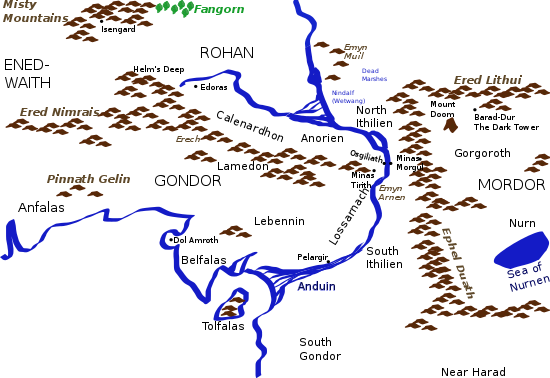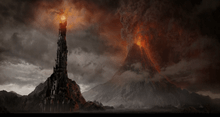Barad-dûr
Barad-dûr (pronounced [bʌrʌˈduːr]), also called the Dark Tower, is a fictional place in J. R. R. Tolkien's Middle-earth writings and is described in The Lord of the Rings, The Silmarillion, and other works. It is an enormous fortress of the Dark Lord Sauron, whence he rules the volcanic and barren land of Mordor. Located in northwest Mordor, near Mount Doom, the Eye of Sauron keeps watch over Middle-earth from its highest tower.[1] The Lieutenant of Barad-dûr is the Mouth of Sauron, an ambassador and herald for Mordor and Sauron.
| Barad-dûr | |
|---|---|
| J. R. R. Tolkien's legendarium location | |
| Information | |
| Type | Vast fortress and tower of Sauron |
| Ruler | Sauron |
| Other name(s) | the Dark Tower (of Mordor) Lugbúrz (Black Speech) |
| Location | At the end of an offshoot of the Ash Mountains in Mordor |
| Lifespan | Second Age c. 1600 to Third Age 3019 |
Barad-dûr was completed by Sauron in the Second Age. It was destroyed following the victory of the Last Alliance of Elves and Men at the end of that age. Rebuilding began in the Third Age, 67 years before the War of the Ring. As the Dark Tower was held together by Sauron's power, it collapsed upon the destruction of the One Ring.
Etymology
In Tolkien's invented Elvish language Sindarin, Barad-dûr is from barad "tower" and dûr "dark". It was called Lugbúrz in the Black Speech of Mordor, with the same meaning; it is composed of lug "tower" and búrz "dark".[2] The Black Speech (created by Sauron) was one of the languages used in Barad-dûr. The soldiers there used a debased form of the tongue.[T 1] In The Lord of the Rings "Barad-dûr," "Lugbúrz," and "the Dark Tower" are occasionally utilized as metonyms for Sauron.[T 2]
Geography

The Dark Tower stood at the end of a south-western offshoot of the Ash Mountains (Ered Lithui), the range that ran eastwards from the Black Gate of Mordor. Barad-dûr rose above the arid plain of Gorgoroth,[T 3] and lay south-east of Udûn and the Black Gate.
From the fortress's east entrance a road went north then west to the Isenmouthe.[T 4][3] Frodo and Sam travelled part of this route on their way south to Mount Doom. A second route "Sauron's Road" went from the west gate of Barad-dûr westwards across Gorgoroth to Mount Doom's "Chambers of Fire." This road ran from Barad-dûr between two smoking chasms and then reached the causeway that led to the mountain.[T 5] Strachey's Journeys of Frodo estimates Mount Doom was probably no more than 10 miles west of Barad-dûr because Sauron's Road from Barad-dûr to the causeway was only a league (about 3 miles) long.[4] From Mount Doom the road went southwest to Minas Morgul.
Description
In The Two Towers Barad-dûr is described as:
- "...that vast fortress, armoury, prison, furnace of great power..."[T 6]
The same paragraph goes on to say the Dark Tower had 'immeasurable strength'. The fortress was constructed with many towers and was hidden in clouds about it:
- "...rising black, blacker and darker than the vast shades amid which it stood, the cruel pinnacles and iron crown of the topmost tower of Barad-dûr."[T 5]
It could not be clearly seen because Sauron created shadows about himself that crept out from the tower.[T 7] In Frodo's vision on Amon Hen, he perceived the immense tower as:
- "...wall upon wall, battlement upon battlement, black, immeasurably strong, mountain of iron, gate of steel, tower of adamant... Barad-dûr, Fortress of Sauron."[T 8]
"Tower of adamant" is probably intended to suggest the tower was composed of extremely hard material.[1] There was a look-out post, the "Window of the Eye", at the top of the tower. This window was visible from Mount Doom where Frodo and Sam had a terrible glimpse of the Eye of Sauron.[T 7]
Barad-dûr's west gate is described as "huge" and the west bridge as "a vast bridge of iron."[T 5] This spanned a deep abyss and carried Sauron's Road from the gate to Mount Doom.
In The Return of the King, Sam Gamgee witnessed the destruction of Barad-dûr:
- "... towers and battlements, tall as hills, founded upon a mighty mountain-throne above immeasurable pits; great courts and dungeons, eyeless prisons sheer as cliffs, and gaping gates of steel and adamant..."[T 7]
History
The Second Age
Sauron began to stir again and chose Mordor as a stronghold in which to build his fortress.[5] It was strengthened by the power of the One Ring, which was also forged around 1600. Gandalf described the Ring as being the "...foundation of Barad-dûr..."[T 9]
Sauron was challenged by a mighty host from Númenor. He submitted to their king and was taken captive to Númenor. He returned to Mordor a year after the downfall of Númenor.
Sauron attacked Gondor, which resulted in Elendil and Gil-galad forming the army of the Last Alliance of Elves and Men. The host entered Mordor and besieged Barad-dûr. During the siege, Elendil's son Anárion was slain by a stone flung from the fortress. Sauron himself came forth from the Dark Tower and fought against Elendil and Gil-galad. Though they were killed in combat, Sauron was also cast down. Anárion's brother Isildur cut the Ring from Sauron's hand and Sauron was overthrown. Sauron's armies were defeated and Barad-dûr was captured and levelled to the ground. However, the foundations could not be removed while the Ring still existed.
The Third Age
Sauron had been exiled from Mordor which was under the guard of the men of Gondor for a time. He subsequently built the fortress of Dol Guldur in Greenwood the Great. Due to the Great Plague, Gondor was unable to continue to man its forts, and Mordor was left unguarded. Minas Ithil was besieged and captured by the Nazgûl, and it was renamed Minas Morgul. Its palantír was seized and taken to Barad-dûr.[T 10][T 11]
When Dol Guldur was attacked by the White Council, Sauron withdrew from Mirkwood, and the following year returned secretly to Mordor, where he rebuilt Barad-dûr. The fortress could be rebuilt quickly because the foundations were still in place.[1]
Barad-dûr was destroyed for the final time when Gollum took the Ring from Frodo and fell into the Cracks of Doom. The Ring was destroyed and Sauron was defeated.
Concept and creation
In J. R. R Tolkien's The Fellowship of the Ring, the Dark Tower is described as being composed of iron, being black in colour and having battlements and gates.[T 8] In the painting the walls are of mainly grey stone and brick, and battlements, gates and towers are not visible. The notes accompanying a painting in Pictures by J. R. R. Tolkien describe it as follows:
- "The painting shows a door on the eastern side of the fortress with Mount Doom to the westward."[T 12]
Adaptations

For Peter Jackson's The Lord of the Rings film trilogy (2001–2003), Richard Taylor and his design team built an 18 ft (5 m) high miniature ("big-ature") of Barad-dûr.[6] Jackson's The Lord of the Rings: The Return of the King movie (2003) showed Barad-dûr as clearly visible from the Black Gate of Mordor, which is not the case in the book. Jackson portrayed Barad-dûr, like the other enemy fortresses of Isengard, Minas Morgul and the Black Gate, in "an exaggerated Gothic fashion" with a black metallic appearance.[7] In The Lord of the Rings, the Eye was within the "Window of the Eye" in the topmost tower, whereas in Jackson's film trilogy the Eye appeared between two horn-like spires that curved upwards from the tower top.
References
Primary
- This list identifies each item's location in Tolkien's writings.
- The Return of the King, Appendix F
- The Return of the King, Index: III "Persons, Places, and Things"
- The Silmarillion, "Of the Rings of Power and the Third Age"
- In Pictures by J. R. R. Tolkien there is a picture of Barad-dûr which shows the entrance on the east side of the Dark Tower. Tolkien, J.R.R. (1979), "Picture 30 Orodruin and Barad-dûr," Foreword and Notes by Tolkien, C. Pictures by J. R. R. Tolkien, (Hardback ed.) London: George Allen & Unwin, ISBN 0047410035
- The Return of the King, "Mount Doom"
- The Two Towers, "The Road to Isengard"
- The Return of the King, "Mount Doom,"
- The Fellowship of the Ring, "The Breaking of the Fellowship"
- The Return of the King, "The Last Debate"
- The Return of the King, "Appendix A"
- The Return of the King, "Appendix B"
- Tolkien, J. R. R. (1979). "Picture 30: Orodruin and Barad-dûr". In Tolkien, C. (ed.). Pictures by J. R. R. Tolkien: Foreword and Notes by Tolkien, C. (1979 (Hardback) ed.). London: George Allen & Unwin. ISBN 0047410035.
Secondary
- "Barad-dûr". The Encyclopedia of Arda. 25 September 2008.
- Allan, J. (1978). "The Black Speech". In Allan, J. (ed.). An Introduction to Elvish (reprinted 2002 ed.). Helios: Bran's Head Books. p. 167. ISBN 0905220102.
- Map 47 in Barbara Stratchey’s Journeys of Frodo shows a road going from the east entrance to the Isenmouthe. Strachey, B. (1981), "Map 47," Journeys of Frodo: An Atlas of J. R. R. Tolkien’s The Lord of the Rings, London: Unwin Paperbacks (Reprinted 1984), ISBN 0049120115
- Strachey, B. (1981), "Map 48," Journeys of Frodo: An Atlas of J. R. R. Tolkien's The Lord of the Rings, London: Unwin Paperbacks (Reprinted 1984), ISBN 0049120115
- Foster, Robert (1978). A guide to Middle-earth. New York: Ballantine. p. 21. ISBN 978-0345275479.
- Mathijs, Ernest; Pomerance, Murray (2006). From hobbits to Hollywood : essays on Peter Jackson's Lord of the rings. 3. Amsterdam: Rodopi. p. 208. ISBN 9789042020627. ISSN 1572-3070.
- Woodward, Steven; Kourelis, Kostis (2006). "Urban Legend: Architecture in The Lord of the Rings". In Mathijs, Ernest; Pomerance, Murray (eds.). From Hobbits to Hollywood: Essays on Peter Jackson's Lord of the Rings. Rodopi. p. 203. ISBN 978-9-04201-682-8.
.jpg)